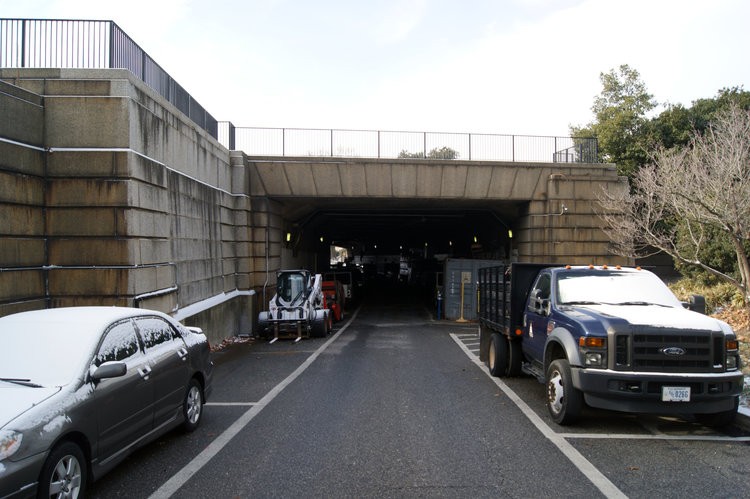On C Street they paved a pair of tracks, put up a parking lot

Exterior view of the C Street streetcar tunnel. Image by Elliot Carter used with permission.
The DC Streetcar expansion is still up in the air, and the current H Street line and now-funded Benning Road extension are only a small fraction of the extensive system that once ran through the region. Nonetheless, they can still evoke memories of the glory days of streetcar travel in the region, which fostered quirky things like the tiny C Street tunnel that went under Senate Park.
Imagine: until 1962, it was possible to take a ride on a President’s Conference Committee (PCC) streetcar through a short tunnel under Senate Park. The brief ride replaced the former above-ground route and allowed a broad, leafy vista from North Capitol Street NW to the Capitol Dome and large fountain to be installed over it.
Image created with Google Maps. 
The original Capital Transit Company network was the product of a consolidation of several companies that united the region’s streetcar system under one banner in 1933. It was around this time that calls for a subway system began to dominate, leading to the construction of the first of only three tunnels.
Construction on the C Street tunnel, which began May 26, 1931, continued until August 15 of that year, resulting in a short structure that ran from New Jersey Avenue to “just east of Delaware Avenue,” the Sunday Washington Star reported.
At the same time, Architect of the Senate David Lynn began work on the parking garage that is now the sole occupant of the underground space.
Streetcar in front of the Capitol building by Library of Congress.
At just 215 feet, the tunnel offered little more than a brief passage through a highly-trafficked area. However, the reasoning was arguably sound: instead of wiggling from C Street to Delaware Avenue to B Street, streetcars could make their way right through to a quick turn up to Union Station.
As a bonus, according to the Sunday Washington Star, the tunnel would “remove the C Street cars from view as they pass the Capitol.” This was not the only view-improving measure added to the project: trees and bushes were planted in order to prevent streetcars from sullying the sightlines that gave Senate Park visitors an unobstructed view of the Capitol dome.
Subway by the Senate office building by Library of Congress.
Senate Park contains Senate Fountain, a monolithic structure built in 1932 that is one of the centerpieces of a grounds beautification effort undertaken by Architect of the Capitol David Lynn. A tunnel, however short, made sense to him because it would frame the beauty of this marvelous work of art.
The Senate Fountain. Image by Architect of the Capitol.
Until the Bureau of Engraving station and the Dupont Circle streetcar station opened in 1949, the only underground public transit in the District was this tiny tunnel. These latter two tunnels, which were relatively short and were created to ease traffic congestion, were symptomatic of the growing public demands to bury streetcars in order to speed up service and reduce conflicts with increasingly prevalent personal vehicles.
The C Street tunnel today. Image by the author.
Today, the C Street tunnel is undergoing construction for a large renovation project and is expected to reopen in 2020. Fencing around the parking garage makes it difficult to see the complete superstructure of the park, garage, and tunnel, but the portals on either end are still visible.
The C Street tunnel today. Image by the author.
To find the tunnel’s portals, simply proceed to C Street at either side of Senate Park. Streetcars would have taken the northern of the two portals, and cars use the southern set for parking.

